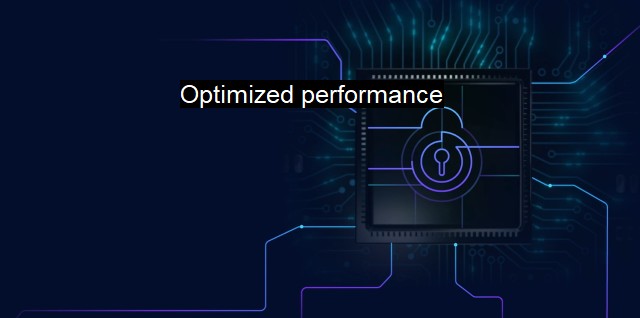What is Optimized performance?
Enhancing Cybersecurity: Exploring Optimized Performance Strategies for Antivirus Software
Optimized performance in the context of cybersecurity and antivirus relates to the highest level of functioning derived from cybersecurity software. Implementing cybersecurity can have significant overhead on the system resources, especially processing power and memory consumption, which forces antivirus solutions to carefully balance their protective capabilities with the demand for speedy computing. Efficient security programs make good use of system resources, causing the least interruption while providing maximum protection, which effectively refers to optimized performance.Optimized performance necessitates the utilization of the minimum amount of system resources and ensuring the quickest response times. Resources involve processing power and memory; hence an efficient antivirus system needs to consume less of these resources. If a cybersecurity program is excessively resource-intensive, it can subsequently diminish the system's overall performance. This can result in slower processing speeds, fewer tasks being executed simultaneously, decreased storage space, and delayed reaction times, all of which undermine the end-user experience.
Quick response times are perhaps among the most integral aspects of optimized performance in the context of cybersecurity. Viruses, malware, and other cyber threats work incredibly quickly, causing damage, stealing information, or creating vulnerabilities within mere seconds or minutes of invading a system. Thus, cybersecurity systems need to respond even more instantly to block, reduce or mitigate these threats without interrupting the smooth workflow. A well-optimized cybersecurity program will detect and deal with cyber threats speedily, often with real-time scanning and defense capabilities.
The detection rates play a vital part in optimized performance as well. Having high detection rates is a crucial aspect of antivirus software; hurrying up system checks while missing certain threats makes optimization meaningless. A perfect combination is a swift, in-depth scanning process delivering impeccable detection rates. This implies covering scan speeds, the ability to perform scheduled scanning, idle-scanning, rapid remediation, and weighted false positives.
Minimum lag and system interruptions are significant in optimized performance. Interferences in system performance due to cybersecurity measures can be considered as detrimental as the cyber threats they aim to guard against. Downtime, system lags, and slow processing speeds can negatively affect businesses' productivity. Optimized antivirus software allows protection updates and scans to run in the background with zero or minimal effect.
Scalability is worth mentioning when discussing optimized performance. With cybersecurity threats growing exponentially and becoming more advanced, antivirus software must be scalable. This means it should pivot with new threats, increase or decline in resources use as necessary without causing system overloads, crashes, or unnecessary vulnerability.
Lastly, constant innovation and updates are part of optimized performance. With an ever-changing cyber threat landscape, an antivirus solution providing optimized performance is characterized by its ability to evolve perpetually. Regular software updates play a critical role in maintaining this level of performance, ensuring that the protection strategies employed are in alignment with the continuously changing risk profiles, intrusion techniques, exploits, and delivery methods used by cybercriminals.
Optimized performance in cybersecurity is not just about consuming fewer resources or detecting and responding to threats faster. It encapsulates numerous other measures like high detection rates, deft use of system resources, scalability, innovative updates, and minimal disruption to the system. Such an approach helps make most out of every computing resource while guaranteeing a substantive layer of protection, along with excellent user experience.

Optimized performance FAQs
What is optimized performance in the context of cybersecurity and antivirus software?
Optimized performance refers to the ability of cybersecurity and antivirus software to efficiently protect a computer or network from threats without causing significant slowdowns or disruptions to other processes. It involves striking a balance between effective threat detection and minimal system resource consumption.What are the benefits of optimized performance in cybersecurity and antivirus software?
Optimized performance allows for smoother and faster operation of computer systems, reducing the risk of performance issues or crashes. It also improves the overall user experience, as there is minimal disruption to daily tasks. Additionally, optimized performance helps to ensure that the software remains effective in detecting and mitigating threats, reducing the risk of successful attacks.How can I optimize the performance of my antivirus software?
To optimize the performance of your antivirus software, you should regularly update it to ensure it has the latest threat definitions and software patches. You should also configure the software to exclude any non-critical files or applications that do not need to be scanned. Disabling unnecessary features, such as real-time scanning, can also help to reduce resource usage. Finally, you may consider upgrading your computer's hardware to provide more resources for the antivirus software to use.What are some indicators of poor performance in cybersecurity and antivirus software?
Poor performance in cybersecurity and antivirus software can manifest in several ways, including significant slowdowns or freezes of the computer or network, increased resource consumption by the software, and failure to detect or mitigate threats. In some cases, poor performance may also result in false positives or missed detections, indicating that the software is not functioning properly.| | A | | | B | | | C | | | D | | | E | | | F | | | G | | | H | | | I | | | J | | | K | | | L | | | M | |
| | N | | | O | | | P | | | Q | | | R | | | S | | | T | | | U | | | V | | | W | | | X | | | Y | | | Z | |
| | 1 | | | 2 | | | 3 | | | 4 | | | 7 | | | 8 | | |||||||